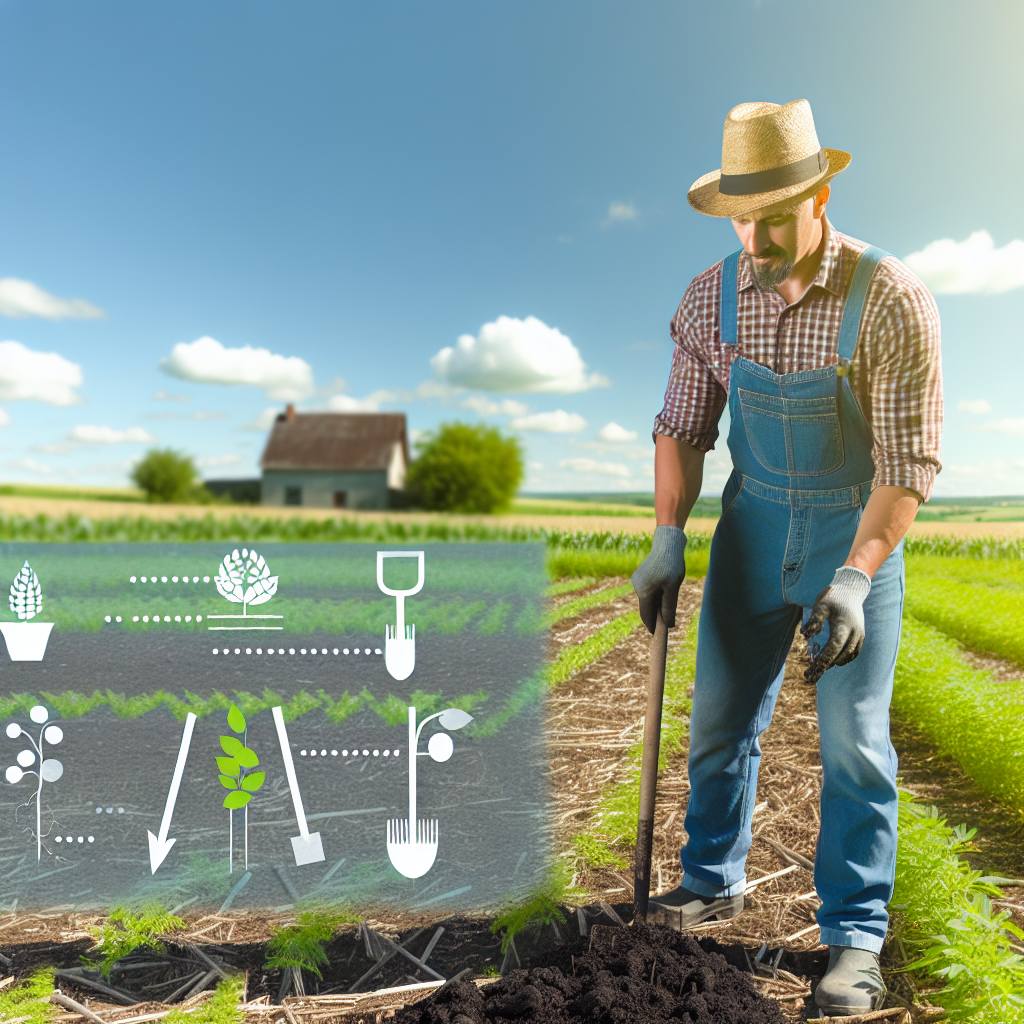Understanding the Role of Soil Carbon in Ecosystem Health
Significance of Soil Carbon
Soil carbon plays a vital role in ecosystem health.
It serves as a primary energy source for soil microorganisms.
These microorganisms are essential for nutrient cycling.
Healthy soil carbon levels enhance soil structure and fertility.
In addition, they improve water retention in the soil.
Impact on Climate Change
Increasing soil carbon can mitigate climate change effects.
It helps sequester carbon dioxide from the atmosphere.
This process reduces greenhouse gases and cools the planet.
Furthermore, carbon-rich soils can absorb and store more water.
As a result, they become more resilient to droughts and floods.
Biodiversity Support
Soil carbon supports a diverse ecosystem.
High carbon levels promote various soil organisms.
These organisms contribute to nutrient availability and soil health.
Sustainable farming practices can enhance soil carbon levels.
By doing so, they help maintain biodiversity in agriculture.
Transform Your Agribusiness
Unlock your farm's potential with expert advice tailored to your needs. Get actionable steps that drive real results.
Get StartedImproving Agricultural Productivity
Healthy soil carbon levels boost agricultural productivity.
They provide essential nutrients for crops throughout the growing season.
Increased soil fertility leads to higher crop yields.
Furthermore, it reduces the need for chemical fertilizers.
Sustainable practices ensure long-term productivity and soil health.
Overview of Sustainable Farming Practices for Soil Improvement
Understanding Soil Health
Soil health is vital for sustainable farming.
Healthy soil supports plant growth and biodiversity.
Moreover, it enhances water retention and nutrient cycling.
Practices to Enhance Soil Carbon
Implementing cover cropping significantly improves soil carbon levels.
Cover crops reduce erosion and enhance soil structure.
They also contribute organic matter when turned under.
Crop rotation is another effective technique.
This method helps break pest cycles and improve soil nutrients.
Diversifying crops can enhance soil microbial diversity.
Incorporating organic fertilizers enriches soil carbon naturally.
These fertilizers improve soil structure and microbial activity.
Composting creates valuable organic amendments for soil health.
Minimizing Soil Disturbance
Practicing no-till farming preserves soil structure and carbon.
This method reduces erosion and promotes biodiversity.
Soil microorganisms thrive in undisturbed environments.
Moreover, minimal disturbance allows natural processes to occur.
It enhances water infiltration and nutrient availability.
Utilizing Agroforestry Systems
Agroforestry integrates trees into farming systems.
This approach boosts carbon sequestration in the soil.
Showcase Your Farming Business
Publish your professional farming services profile on our blog for a one-time fee of $200 and reach a dedicated audience of farmers and agribusiness owners.
Publish Your ProfileTrees offer shade, reduce soil erosion, and enhance biodiversity.
Additionally, they improve soil structure and fertility.
Roots of trees promote nutrient cycling and water retention.
Regular Soil Assessment
Regularly assessing soil health guides effective practices.
Soil testing reveals nutrient levels and pH balance.
This information helps tailor specific amendments for improvement.
Furthermore, monitoring soil health tracks long-term changes.
It allows farmers to adjust strategies based on soil conditions.
The Impact of Crop Rotation on Soil Carbon Sequestration
Understanding Crop Rotation
Crop rotation involves alternating different crops in a specific sequence over multiple growing seasons.
This practice enhances soil health by preventing the depletion of specific nutrients.
Moreover, it disrupts pest and disease cycles, reducing the need for chemical interventions.
Benefits of Crop Rotation for Soil Carbon
Crop rotation significantly boosts soil carbon sequestration.
Diverse crops improve soil organic matter, leading to enhanced carbon storage.
Additionally, different root structures contribute to healthier soil dynamics.
Crops like legumes fix nitrogen, benefiting subsequent crops.
Mechanisms Behind Carbon Sequestration
Plants capture carbon dioxide during photosynthesis, storing carbon in their biomass.
As crops decompose, they add organic matter to the soil.
This process helps form stable soil organic carbon compounds.
Studies Supporting Crop Rotation Effects
Research confirms the positive effects of crop rotation on soil health.
A study conducted by the Rodale Institute showcased increased soil carbon levels through diverse cropping systems.
Further studies from Iowa State University revealed how rotating cover crops improved soil structure and microbial activity.
Implementing Crop Rotation Strategies
Farmers should evaluate their specific conditions before starting a rotation plan.
Integrating legumes into cereal rotations can maximize nitrogen benefits.
Moreover, including cover crops after harvest helps maintain soil cover and prevent erosion.
Regular soil tests will inform adjustments needed for optimal productivity.
Challenges and Considerations
Though beneficial, implementing crop rotation may require upfront knowledge and adjustments.
Farmers must monitor crop performance closely throughout the rotation cycles.
Additionally, weather variations can influence the effectiveness of these strategies.
Moving Towards Sustainable Practices
Embracing crop rotation contributes to a more sustainable agricultural system.
This practice not only improves soil carbon levels but also enhances overall ecosystem health.
By implementing crop rotation, farmers can foster resilience against climate change.
Find Out More: Benefits of Cover Cropping for Water Efficiency
Utilizing Cover Crops to Enhance Soil Organic Matter
The Role of Cover Crops
Cover crops play a crucial role in improving soil quality.
They prevent soil erosion and reduce nutrient runoff.
Additionally, cover crops enhance soil organic matter.
This process boosts the overall fertility of the soil.
Types of Cover Crops
Different types of cover crops can be utilized effectively.
- Legumes, such as clover and vetch, fix nitrogen in the soil.
- Brassicas, like radishes, improve soil structure.
- Grasses, such as rye, help to hold soil in place.
Choosing the right cover crop depends on specific agricultural needs.
Best Practices for Cover Crop Use
Implementing best practices ensures cover crops provide maximum benefits.
Firstly, select cover crops suited to your region’s climate.
Showcase Your Farming Business
Publish your professional farming services profile on our blog for a one-time fee of $200 and reach a dedicated audience of farmers and agribusiness owners.
Publish Your ProfileSecondly, plant them during the off-season or after harvests.
Incorporating cover crops into crop rotation enhances diversity.
Finally, manage cover crops effectively to prevent pest issues.
Benefits of Increased Soil Organic Matter
Increasing soil organic matter offers numerous benefits.
- It improves water retention capabilities.
- Higher organic matter leads to improved microbial activity.
- Additionally, it increases nutrient availability for plants.
These benefits contribute to more sustainable farming practices.
Explore Further: Reducing Pesticide Use with Integrated Pest Management
The Benefits of Reduced Tillage for Soil Carbon Levels
Understanding Reduced Tillage
Reduced tillage refers to minimal soil disturbance during farming.
This technique enhances soil structure and promotes carbon storage.
Farmers can adopt various methods, including no-till and strip-till.
Increasing Soil Carbon Sequestration
Reduced tillage significantly increases soil carbon sequestration.
By minimizing soil disturbance, farmers preserve organic matter.
As a result, carbon that would otherwise escape remains in the soil.
Enhancing Soil Health
This practice improves overall soil health and resilience.
It encourages the growth of beneficial microorganisms in the soil.
Additionally, it increases nutrient availability for crops.
Reducing Soil Erosion
One major benefit of reduced tillage is the reduction of soil erosion.
With less disturbance, soil retains its structure better.
This stability prevents the loss of fertile topsoil during heavy rain.
Supporting Biodiversity
Reduced tillage promotes biodiversity in the soil ecosystem.
A diverse microbiome is essential for healthy crop growth.
Each species plays a role in nutrient cycling and disease suppression.
Improving Water Retention
Less tillage improves the soil’s ability to retain moisture.
This trait is particularly valuable in drought-prone areas.
With enhanced water retention, crops can thrive under stress.
Economic Advantages
Farmers experience economic benefits from reduced tillage practices.
Lower fuel costs result from fewer machinery runs.
Additionally, better soil health often leads to higher yields.
Find Out More: Sustainable Pest Control with IPM Practices
Integrating Livestock and Crops to Optimize Soil Health
The Role of Livestock in Sustainable Farming
Integrating livestock into crop farming boosts soil carbon levels significantly.
Livestock contribute organic matter through manure, enhancing soil structure.
This organic matter also fosters beneficial microbial activity in the soil.
Furthermore, using livestock for grazing can help control weeds naturally.
Thus, a balanced integration can create a synergistic farming system.
Cereal-Legume Rotations
Rotating cereals and legumes improves soil nitrogen content effectively.
Legumes fix atmospheric nitrogen, enriching the soil for subsequent crops.
This practice enhances crop yields while minimizing synthetic fertilizer use.
Additionally, diverse crop rotations break pest cycles and reduce diseases.
Cover Cropping
Utilizing cover crops is vital for protecting and enriching soil health.
These crops prevent erosion and enhance soil moisture retention significantly.
They also sequester carbon, contributing to overall soil carbon increase.
Showcase Your Farming Business
Publish your professional farming services profile on our blog for a one-time fee of $200 and reach a dedicated audience of farmers and agribusiness owners.
Publish Your ProfileMoreover, cover crops support beneficial organisms, enriching the soil ecosystem.
Holistic Grazing Practices
Implementing holistic grazing can enhance pasture health and soil carbon levels.
This method promotes grass regrowth, improving root structures deeply.
Consequently, healthy roots store more carbon in the soil.
In addition, holistic grazing reduces land degradation and improves biodiversity.
Precision Farming Techniques
Employing precision farming maximizes the efficiency of resources used.
This technology monitors soil health in real-time, aiding informed decision-making.
As a result, farmers can apply fertilizers and amendments optimally.
Precision techniques ultimately reduce waste and improve soil condition.
You Might Also Like: Conservation Tillage Explained For Sustainable Farming

Assessing the Role of Biochar in Carbon Retention in Soil
Understanding Biochar
Biochar is a carbon-rich material derived from biomass.
It results from pyrolysis, a process that heats organic material in low oxygen.
This process converts waste into a stable form of carbon.
Farmers increasingly recognize its potential for soil enhancement.
Benefits of Biochar in Soil
Biochar improves soil structure and aeration.
Additionally, it enhances water retention capacity in soil.
This feature is essential for drought-prone areas.
Moreover, biochar helps retain nutrients, reducing fertilizer needs.
Mechanism of Carbon Sequestration
Biochar locks carbon in a stable form for years.
This makes it an effective tool for climate change mitigation.
As microorganisms break down organic matter, they leave behind biochar.
This process enhances carbon retention in soil.
Global Implementations and Studies
Research shows significant increases in soil carbon with biochar amendments.
A study in Brazil demonstrated a 20% increase in carbon retention.
Comparative studies revealed that biochar outperforms traditional organic matter.
Furthermore, projects in Africa showed improved crop yields.
Challenges and Considerations
Despite its benefits, the production of biochar requires energy.
Moreover, sourcing biomass sustainably is crucial.
In some cases, improperly managed biochar can release pollutants.
Therefore, careful management practices are necessary for optimal results.
Measuring Soil Carbon Stocks
Importance of Assessing Soil Carbon
Assessing soil carbon is crucial for sustainable agriculture.
It helps understand the impact of farming practices on the environment.
Additionally, measuring soil carbon supports climate change mitigation efforts.
Methods of Soil Carbon Measurement
Various methods exist to measure soil carbon stocks effectively.
These methods can be categorized into direct and indirect approaches.
Direct Methods
Direct methods involve collecting soil samples for analysis.
This technique provides accurate measurements of soil carbon content.
Common direct methods include:
- Soil core sampling
- Bulk density measurements
- Laboratory analysis of carbon concentration
Indirect Methods
Indirect methods estimate soil carbon using different techniques.
For instance, remote sensing offers valuable data over large areas.
Showcase Your Farming Business
Publish your professional farming services profile on our blog for a one-time fee of $200 and reach a dedicated audience of farmers and agribusiness owners.
Publish Your ProfileFurthermore, modeling approaches predict carbon stocks based on existing data.
These methods can be quicker than direct sampling.
Common indirect methods include:
- Remote sensing technology
- Soil organic carbon models
- Geostatistical methodologies
Technological Advancements in Soil Carbon Measurement
Recent advancements have improved soil carbon measurement accuracy.
Technologies like near-infrared spectroscopy enhance data collection.
Moreover, data analytics streamlines processing and interpretation.
These improvements result in better decision-making for farmers.
Consequently, farmers can implement strategies to enhance soil carbon stocks.
Challenges in Measuring Soil Carbon
Several challenges complicate soil carbon measurement efforts.
Variability in soil types requires tailored approaches.
Additionally, seasonal changes can affect carbon levels in soils.
Implementation of effective measurement strategies can overcome these obstacles.
Future Directions in Soil Carbon Measurement
Future research aims to refine soil carbon measurement techniques.
Innovations will likely focus on integrating various technologies.
For instance, combining remote sensing with ground-truthing enhances accuracy.
Such advancements will ultimately support sustainable farming practices.
Policy Implications and Incentives for Farmers to Improve Soil Carbon
Importance of Soil Carbon
Soil carbon plays a crucial role in agriculture.
It enhances soil fertility and supports crop growth.
Moreover, it contributes to climate change mitigation.
Government Policies Promoting Soil Carbon Initiatives
Government policies can significantly influence farming practices.
Financial incentives encourage farmers to adopt sustainable methods.
These methods include cover cropping and reduced tillage.
Furthermore, governmental support can help fund research.
This research identifies effective soil carbon strategies.
Incentive Programs for Farmers
Several incentive programs exist to motivate farmers.
For instance, carbon credit programs reward farmers.
Farmers receive credits for sequestering carbon in the soil.
Additionally, grants and subsidies assist in funding sustainable practices.
Examples of Successful Initiatives
Many regions successfully implemented soil carbon initiatives.
The Climate Smart Agriculture program exemplifies such efforts.
Farmers participating report improved soil health and yields.
They also see increased resilience to climate impacts.
Challenges and Solutions
Despite the benefits, challenges persist for farmers.
Financial constraints can limit participation in programs.
Additionally, knowledge gaps hinder effective implementation.
Education and support systems can bridge these gaps.
Workshops and training ensure farmers are well-informed.
Future Directions for Policy Development
Future policies must prioritize sustainable farming practices.
Encouraging research into innovative soil management techniques is vital.
Furthermore, creating more accessibility to funding improves participation.
Showcase Your Farming Business
Publish your professional farming services profile on our blog for a one-time fee of $200 and reach a dedicated audience of farmers and agribusiness owners.
Publish Your ProfileBuilding partnerships with local organizations can enhance effectiveness.
Ultimately, a collaborative approach maximizes benefits for all stakeholders.
Case Studies: Successful Implementation of Carbon-Sequestering Practices
Regenerative Agriculture in Iowa
Northern Iowa farmers adopted regenerative agriculture practices recently.
They focused on cover crops, reduced tillage, and crop rotation.
This approach significantly improved soil carbon levels over three years.
As a result, their yields also increased due to healthier soil.
Farmers reported enhanced biodiversity in their fields.
Community involvement in education played a crucial role.
Agroforestry in Oregon
An Oregon-based farm implemented agroforestry techniques successfully.
They integrated trees with traditional crops, creating a unique environment.
This practice captured additional carbon dioxide from the atmosphere.
The farm noted improved soil structure and water retention.
Additionally, it provided habitat for various wildlife species.
Farmers shared their experiences in local workshops and seminars.
Organic Farming in Florida
In Florida, a group of organic farmers collaborated on carbon-sequestering methods.
They utilized composting and organic fertilizers to enrich the soil.
This reduced their dependence on synthetic chemicals significantly.
Over five years, soil carbon content increased markedly.
Farmers observed enhanced resilience to drought conditions as well.
Networking among farmers facilitated the sharing of best practices.
Holistic Grazing in Texas
A ranch in Texas adopted holistic grazing management recently.
This technique involved rotational grazing to improve pasture health.
Sole carbon levels rose as a direct result of this practice.
Grassland health improved, promoting a thriving ecosystem.
The ranch experienced higher cattle weights and better profits.
Collaboration with local environmental groups strengthened the initiative.




